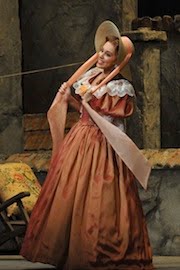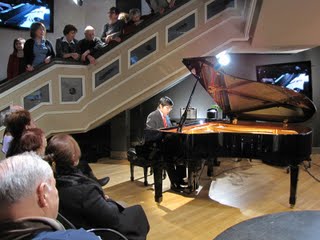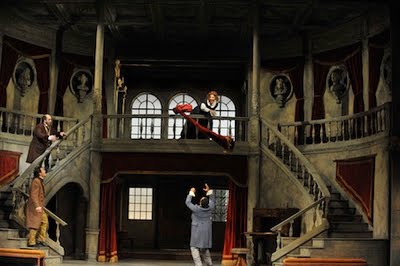The star of any production of Don Pasquale  has to be Don Pasquale himself. The veteran Italian bass Donato Distefano played the mean old bachelor for every possible laugh and sang his music with great verve. Slovakian soprano Adriana Kucerova (photo: right), making her American stage debut, proved to be not only a fine singer but also a talented comedienne. No wonder she is in great demand all over the world! Tenor Norman Shankle, as Ernesto, exhibited a pleasing lyric voice but didn’t seem to have enough volume for the climactic moments. Baritone Nathan Gunn as Dr. Malatesta cut his usual handsome figure and showed considerable comic flair.
has to be Don Pasquale himself. The veteran Italian bass Donato Distefano played the mean old bachelor for every possible laugh and sang his music with great verve. Slovakian soprano Adriana Kucerova (photo: right), making her American stage debut, proved to be not only a fine singer but also a talented comedienne. No wonder she is in great demand all over the world! Tenor Norman Shankle, as Ernesto, exhibited a pleasing lyric voice but didn’t seem to have enough volume for the climactic moments. Baritone Nathan Gunn as Dr. Malatesta cut his usual handsome figure and showed considerable comic flair. Generally speaking, the production was excellent: the cast was first-rate; the sets and costumes by the late Jean-Pierre Ponnelle were just right; the stage direction by Candace Evans was full of fun; and conductor Stefano Ranzani did his work with efficiency and charm.
Constant Stream of Funny Business Keeps Audience in Stitches!
I assume that the inspired, very effective mime episodes played in front of the curtain during the scene changes were the inspiration of director Candace Evans. These and the accompanying wry, humorous supertitles added significantly to the overall comedic effect.
Unfortunately, I can’t say as much for the upstaging that went on during some of the arias, nor could I make much of the silly painting Ernesto worked away on at various points in the opera. It was in a colorful style quite at odds with Ponnelle’s subdued grays and browns. Why was it there? What did it represent? I didn’t get the point, if there was one.
Overall, Evans showed a remarkable talent for inventing genuinely funny bits of business. Some of the bits misfired, but the only real test is audience reaction, and there was plenty of laughter at the performance I attended.
Don Pasquale is currently running in rep with Mozart’s Cosi fan tutte at the Dallas Opera. These are both intimate, small-scale operas, productions of which, in my estimation, would have been ludicrous at the old Fair Park facility. Dallas Opera archives show they were done there anyway!
But all that is past history! In the Margo and Bill Winspear Opera House opera house, the dozens of intimate small-scale operas in the repertoire can be seen and heard as they were intended to be seen and heard. Even operas such as Verdi’s Falstaff or Britten’s Death in Venice, neither of which the Dallas Opera has ever done, will benefit enormously from being presented in the Winspear Opera House.
Although the orchestra required for Don Pasquale is small, the pit in the new house is large enough to accommodate the sizeable orchestras required for operas by Wagner and Strauss.
Yet to come this season are Puccini’s Madama Butterfly and Jake Heggie’s new opera Moby Dick starring Ben Heppner. I can’t wait.
First Impressions of Dallas Opera’s New Home
The Margo and Bill Winspear Opera House is the latest addition to the rapidly evolving Dallas Arts District. When finished, this area will undoubtedly be a source of tremendous civic pride for generations to come. Already, within walking distance of each other, are the Dallas Museum of Art, the Nasher Sculpture Garden, and the Trammel Crowe Asian Art Museum. From these one can stroll to the Myerson Symphony Center, home of the Dallas Symphony, and the new opera house, right next door.
In discussions about arts facilities, the argument is usually made that the most important thing is the performing space, and indeed it is; however, at a time when the audience for classical music is declining, it may be extremely shortsighted to make the public spaces any less than comfortable and welcoming.
I must confess to being somewhat underwhelmed by the exterior of the Winspear Opera House. At night it glows red and magical, but in the light of a gray winter’s day, it projects no particular aura at all. The entrance is functional rather than imaginative, and the lobby area is gray and unappealing. I had the impression I was walking into a government cafeteria.
The Myerson Symphony Center next door greets the patrons with far more flair and style. I would guess that the architect probably had interesting ideas for the entrance and public areas of the Winspear Opera House, which the budget-cutters ultimately whittled away.
It may well have been the same story for three other recently opened arts facilities. Both the Long Center in Austin (Texas) and the Four Seasons Opera House in Toronto (Ontario, Canada) were forced to cut their lobby areas down to almost nothing. The Disney Concert Hall in Los Angeles also has bare bones, depressing public spaces.
Once inside the house, I began to feel a whole lot better about the place. Most importantly, it is the right size for its primary purpose. Seating 2,200, it is about the same size as the best European opera houses and a far cry from the old Music Hall (3,400) at Fair Park and the gigantic Metropolitan Opera House (3,800). Sitting almost anywhere in the Met in New York for a live performance, one gets little or no idea what the performers even look like (Thank goodness for ‘Live at the Met in HD!')
Inside the hall, the Winspear Opera House actually ‘feels’ intimate and this perception was later reinforced by the performance itself. The seats are comfortable – not always the case in new halls – and there is wood everywhere, on the floors, walls and behind the whitish gold face pieces on each of the balconies.
And the sound? Well, it is rash to generalize after hearing only a single performance, but I would make a number of preliminary observations. I was sitting in what must surely be one of the best seats in the house, in Orchestra Center in row M. From that vantage point most of the singers seemed to project just fine and the orchestra – albeit a medium-sized one of about 55 players for Don Pasquale - seemed to have lots of bass and lots of presence.
On the debit side, I detected an unpleasant muddiness in the lower depths of the orchestra - a persistent lack of clarity and definition. In addition, coordination between singers and orchestra was often ‘hit and miss’ in the quick ensembles.
These may be problems that can be overcome with minor adjustments – moving the instruments to different positions in the pit, asking the timpanist to use harder sticks, etc. As the performers become more familiar with the characteristics of the house, these initial difficulties may well be resolved.
For Those Wanting More…
The Dallas Opera has one of the most useful and exciting websites in the business. It has all the usual information about the current season and how to order tickets, as well as a fantastic education section. There is basic information relating to the history of opera, vocal styles and technical terms, as well as interactive material and toolkits for teachers. For anyone interested in learning more about opera, this is a rewarding website to visit.
One of best items on the website is the blog produced by PR director Suzanne Calvin. It includes video clips from current productions and lectures, news and gossip from the international world of opera, and a dizzying array of local events for opera lovers. Suzanne seems to be everywhere at once leading gallery walks, arranging film nights and wine tastings, and presenting lectures (Barnes & Noble) on lively subjects, such as “Literary Cafes of Paris”. It all makes me wish I lived in Dallas.
The Dallas Opera recently announced its 2010-2011 season, which will open with Mozart’s Don Giovanni and Donizetti’s Anna Bolena in October, then continue with Mussorgsky’s Boris Godunov, Gounod’s Roméo et Juliette, and Verdi’s Rigoletto.
Paul E. Robinson is the author of Herbert von Karajan: the Maestro as Superstar, and Sir Georg Solti: His Life and Music, both available at Amazon.com.
Photos: Karen Almond, the Dallas Opera
 Pianist Avan Yu gives a noon hour concert at The New Classical 96.3 FM on March 1, the 200th anniversary of Frederic Chopin's birthday.
Pianist Avan Yu gives a noon hour concert at The New Classical 96.3 FM on March 1, the 200th anniversary of Frederic Chopin's birthday.




